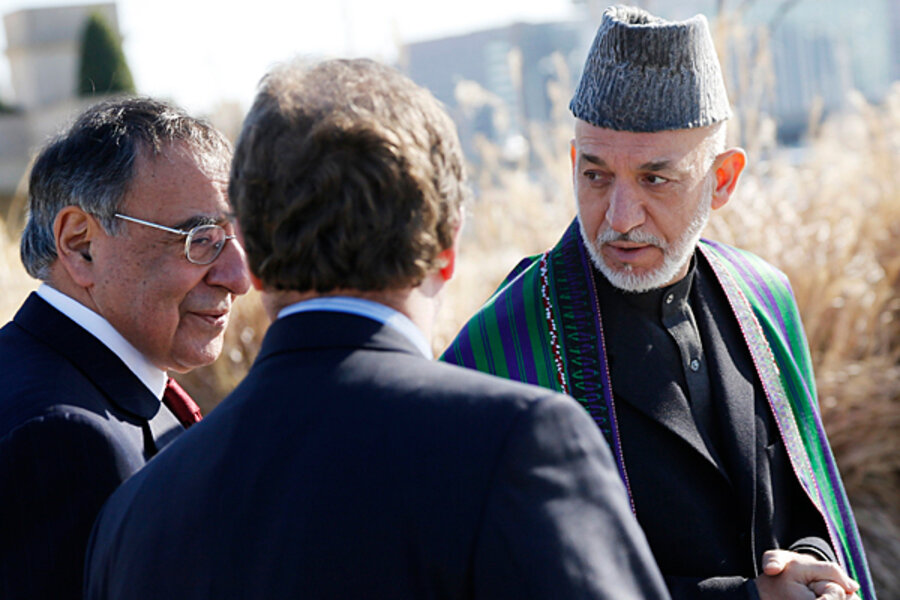As Obama meets Karzai, future troop level in Afghanistan isn't only big issue
Loading...
| Washington
President Obama hosts Afghanistan President Hamid Karzai at the White House for lunch and talks Friday, but the big questions hanging over the visit won’t be answered there. Rather, pressing issues that remain after more than a decade of military involvement in Afghanistan will be resolved by pacts and commitments to be reached over the coming year, as the United States prepares to take its operations against the Taliban and Al Qaeda into a new phase.
Still, the meeting may help to lay the groundwork for the coming year's negotiations. The two leaders are expected to discuss the next steps in the transition from US and other international forces to Afghan security forces, as well as the requirements each side has for reaching a long-term bilateral security agreement, or BSA. Mr. Karzai is also likely to have in his pocket a wish list for military hardware.
That means no one is expecting any concrete decisions on Friday. Long-term stationing-of-forces agreements and civilian aid commitments remain to be worked out. And critical regional diplomacy still lies ahead.
Among those big issues that form the backdrop for Friday’s talks:
- What will it take to continue to deny “safe haven” in Afghanistan to an Al Qaeda that, although diminished, retains its leadership structure across the border in Pakistan?
- What kind of support will the Afghan National Security Forces need over the long term to keep from crumbling – something that could eventually lead to a return to civil war?
- Will it be possible to maintain and even advance the gains in education, development, and women’s and girls’ rights made during 11 years of intense US and international involvement, as the US civilian commitment mirrors the US military drawdown?
The White House insists that “denying Al Qaeda safe haven” is one of Mr. Obama’s two top objectives for long-term US involvement in Afghanistan – the other being to “train and equip” an Afghan military capable of maintaining Afghan sovereignty after NATO departs in 2014. But some critics of administration plans, citing some of the proposals said to be on the table, say the US risks seeing large swaths of the country become once again susceptible to Al Qaeda control.
Some administration officials say Obama is unlikely to keep more than 6,000 troops in the country long-term, while others suggest he is even giving thought to a zero-troops option that would presumably envision carrying out counterterrorism efforts through drones and other remote means.
Speaking with reporters this week, Ben Rhodes, deputy national security adviser for strategic communication, said keeping no troops in Afghanistan post-2014 “would be an option we would consider.” The goal of concluding a BSA with the Afghan government, he reminded reporters, “is not to keep troops” in the country but to do what's necessary to achieve the two “missions” of continuing to train Afghan forces and to deny Al Qaeda safe havens.
Obama’s goal is to conclude negotiations on a security agreement by November, Mr. Rhodes said.
Some critics say an agreement that results in only a few thousand US troops in Afghanistan will fail at Obama’s own objectives. A scant US force on the ground won’t be enough either to keep the Afghan Army controlling its own territory or to carry out sufficient counterterrorist operations, insists Fred Kagan, director of the Critical Threats Project at the American Enterprise Institute in Washington. A proponent of a sizable long-term US presence in Afghanistan, he envisions a US troop level closer to 30,000 troops than to 3,000.
The result of understaffing Afghanistan, he says, will be a steady rise in ungoverned territory ripe for Al Qaeda infiltration.
Also important is what Pakistan, Afghanistan's neighbor, thinks of the long-term commitment the US makes to Afghanistan.
The US has long criticized Pakistani authorities for tolerating (and in some cases encouraging) the havens in zones along the Afghan border where the Taliban and Al Qaeda take refuge. But Pakistani authorities who fear a power vacuum in Afghanistan if the US departs tolerate the presence of those groups as a means of maintaining some influence over events across the border, regional experts say.
Securing a long-term US presence in Afghanistan would reassure the Pakistanis, these experts say, and could result in a more robust effort in tackling the problem of Pakistan’s terrorist refuges.
As the US considers a long-term security agreement with Afghanistan, another question is what happens to the civilian development effort that has expanded education across the country, in particular for girls, developed local governance, and improved health programs and other services?
Related to that is what happens to a national economy that is dependent on significant international military and other expenditures that are about to dry up?
Some development experts say a minimal US military presence, designed only to carry out counterterrorist operations and some training of security forces, would curtail if not doom the civilian effort, because the security that civilian aid workers depend on to get out to project sites would be reduced.
A focus simply on the number of US troops remaining in Afghanistan after 2014 is misplaced, says Anthony Cordesman, a national security and military affairs expert at the Center for Strategic and International Studies (CSIS) in Washington.
“The civil side of the war is at least as critical as the future role of the US military,” Mr. Cordesman says in a recent post on the CSIS website.
Laying the problem of the “missing civil half” of the “civil-military effort” at the feet of the Obama administration, Mr. Cordesman says Obama will have to offer a comprehensive plan for meeting a range of Afghanistan’s security, development, and economic challenges if the case is to be made to stay.






